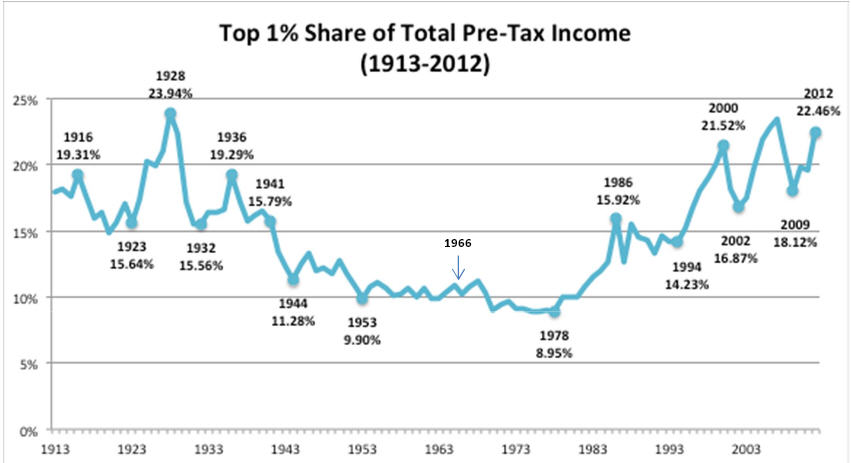For the last few years my wife and I have watched the PBS series, Downton Abbey. The final episode left us with a positive finale to the lives of many of its characters. I believe many have watched the series from remarks made over the last few years.
The series has taken us through a short but tumultuous period of British history. From the sinking of the Titanic in April 1912, WWI, the return from the war, and the roaring 20s, the attention to detail in this series has been superb in my opinion. Rather than a documentary on history with names, dates, and statistics, we have seen this period through the lives of the individual fictitious characters.
One part that rings home from my own research on the financial side of history during this period, was that the US and Europe both disconnected from their history of backing their currencies with gold, and instead devalued their currencies by printing up massive amounts of debt in order to cover their expenses during World War I. You may remember statements by Lord Grantham in episodes how the rapid rise in wage costs had lead them to lay off workers from their estate. Did you know that land prices shot through the roof in the 1910s as the Federal Reserve went into action in 1914, pouring in billions (remember that was a big number for our debt at that time) into the US and global banking system.
While the world of WWI and the 1910s and ‘20s seems like ancient history today, the role of central banks and money have been at the heart of the modern global financial system over the last century. If one seeks to understand where history has brought us and is taking us, one must understand the role of money in the hands of the central banks, the most powerful financial players in our global financial system. One must also understand the history of the world’s only international monetary unit, something most individuals do not know even exist.
The following is a very short summary of various events that prove that a global currency is in fact a development that totally changes everyone’s long term plans. It will be written in the format of diary entries from the last 12 years of my life and our history.
So hang on!
The Modern History of Global Money
Spring 2004
My first understanding of the history of a global currency came from a book written by renown monetary historian and Austrian economist, Dr. Murray Rothbard, A History of Money and Banking in the United States: The Colonial Era To World War II (2002). Below is a look at historical events that took place in 1943 and 1944:
“In the postwar planning for economic affairs, the State Department was in charge of commercial and trade policies, while the Treasury conducted the planning in the areas of money and finance. In charge of the postwar international financial planning for the Treasury was the economist Harry Dexter White….
While the White Plan envisioned a substantial amount of inflation to provide greater currency liquidity, the British responded with a Keynes Plan that was far more inflationary.
The Keynes Plan, moreover, provided for a new international monetary unit, the ‘bancor’, which could be issued by the ICU (a new entity called the International Currency Union. It was never launched) in such large amounts as to provide almost unchecked room for inflation, even in a country with a large deficit in its balance of payments….
Despite extensive concessions, there was no ‘bancor’; the US dollar fixed at $35 per gold once was now firmly established as the key currency base of the world monetary order.”
Rothbard’s book was my first step in not only understanding the foundation of a move toward a global currency in 1943 & 1944, but in truly understanding the modern history of paper money.
I would strongly encourage each of you to visit the Mises Institute’s website.
May 2006
After releasing my industry research paper on short selling, which contains interviews with world famous individuals, as I prepared for my 5th monthly issue to my investment research newsletter a very strong patriot and Christian woman called me from the Washington DC area named Joan Veon. Joan had been encouraged by a friend in 1990 to go to a world UN meeting since she was always researching and reading how material and policies developed at these major conferences was filtering down to educational and government policies around the world. She was always trying to educate her fellow Americans.
She also told me to start watching the developments in the only international monetary unit in our world today, the Special Drawing Rights established by the International Monetary Fund in 1969, just two years before the US government refused to redeem its paper currency for gold in international finance.
In April 2009 it was being introduced to the world as part of the “rescue” to the 2008 credit collapse.
April 2009
“I think a New World Order is emerging and with it, the foundations of a
new and progressive era of international cooperation. We have resolved,
that from today, we will together manage the process of globalization, to
secure responsibility from all and fairness to all, and we have agreed that
in doing so, we will build a more sustainable and more open, and a fairer
global society.” – Gordon Brown, member of the Fabian Socialist Party and Prime Minister of the UK in 2009, comments made to at a G20 Conference in London on April 2, 2009. An actual film of his remarks is linked.
World Leaders Agree On Global Response, Accord in London Quadruples Funding of IMF, but Delays Decisions on Many Divisive Issues, WSJ, April 3 ‘09
“The summit of many of the world’s leading economies in London
announced a tripling of the lending power of the International
Monetary Fund to around $750 billion.They also unveiled a $250 billion expansion in the IMF’s reserve
currency — the special drawing right — to boost liquidity in the global financial system….”
As you can see above, the IMF’s expansion of the ONLY international monetary unit known as the Special Drawing Rights was rapidly expanded in 2009 for the first time in its 40 years of existence.
March 2011
In the spring of 2011 I posted the two research papers to my website showing an expanding role of the Special Drawing Rights in global banking and financial markets. Clearly this international monetary unit was not going away nor merely a topic for academic eggheads.
Reserve Accumulation and International Monetary Stability, 4/13/10
Enhancing International Monetary Stability – A Role for the SDR?, 1/7/11 International Monetary Fund. — posted on March 23 ’11
“From SDR to bancor – A limitation of the SDR (Special Drawing Rights) as discussed previously is that it is not a currency….A more ambitious reform option would be to build on the previous ideas and develop, over time, a global currency. Called, for example, bancor in honor of Keynes, such a currency could be used as a medium of exchange– an ‘outside money’ in contrast to the SDR which remains ‘inside money’.” [see pp 26 – 27 from the April 10 IMF report listed above.]
May 2014
Now we leap to the spring and summer of 2014, to examine the slow move POLITICALLY away from the US dollar as the most widely used currency in the world and frankly, at the very foundation of the substantial improvement of the American way of life since WWII.
During the spring of 2014, I started seeing our various European Allies signing major financial agreements to do business directly between the euro and pound with the Chinese renminbi. These were first in history events. These were nations that had been our allies since WWII. Now they were setting up agreements to do business directly between their currency and China’s currency, which would further reduce the need for the US dollar in global trade.
Bundesbank, PboC Sign Accord To Make Frankfurt Yuan Hub, Bloomberg, 3/28/14
Bank of England and People’s Bank of China Agree on London Yuan Clearing Hub, International Business Times, 4/1/14
2015, May and December
In 2015, China established the Asia Infrastructure Investment Bank, which some saw as a direct attempt to go head to head with the World Bank established by the West in the 1940s. Once again, European nation’s joined the AIIB in spite of pressure from the US.
Why Europe Defies the US to Join A China-Led Bank, DW, 3/18/15
“Despite US pressure to stay out, Europe’s four-largest economies, Germany, France, Britain and Italy, are set to join a China-led regional bank, seen as a potential rival to the US-based World Bank.”
China Officially Launches New Development Bank AIIB, DW, 1/17/16
“China, the world’s second largest economy, has officially launched a development bank that could complement or rival the US-backed World Bank. Regardless, it highlights China’s growing economic clout.”
Finally, we finished 2015 with another first in history, when the IMF approved inclusion of China’s renminbi currency as part of the Special Drawing Right. This is now no longer a possibility. It is now a fact.
The Renminbi Joins the IMFs SDR Basket. Now What?, The Diplomat, 12/1/15
“This is a big moment for China, but its economy still has challenges that it needs to address.”
So as we continue to watch history, unless the citizens of various nation states protest this continued rise in the only global monetary unit, it would appear that when we may find ourselves at the bottom of this current major bust like the spring of 2009, with the high probability that this global money will expand its global reach yet again.
While I see this as a direct threat to the financial sovereignty of each individual nation, the lack of understanding or discussion about this development since 2009 does not bode well for an informed public to reject this threat.
A Sad, but Curious Mind




